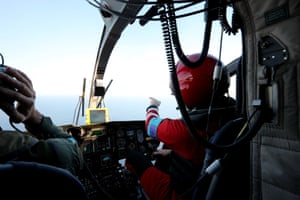“We have approximately five minutes left on station,” the crew on Seagull 75 told the Libyans. “We will go overhead the vessel, the rubber boat, and we will light our landing lights.” The Sophia flight and the Libyan coastguard ship were searching for each other in the dark. “We don’t have your visual, keep an eye out for a light,” said the flight crew. The Libyans asked for more information. “Stand by, I’m just updating your position. Stand by,” the flight crew replied.
“Turn left about 10 degrees. He is approximately three nautical miles off your nose,” replied Operation Sophia after a minute. The flight was out of fuel and about to head back to base. “Libyan national coastguard, we will contact you through FHQ, over,” said the flight crew, referring to the tactical base from which Operation Sophia is managed.
The confusion at sea that night was not an isolated incident but an illustration of the painstaking lengths to which Europe has gone to ensure migrants do not reach the continent. While the level of violence at Greece’s border with Turkey has shocked many Europeans, Europe’s retreat from refugee rights did not begin last week. Greece’s decision to seal its borders and deny access to asylum is only the most visible escalation of an assault on people’s right to seek protection.
The groundwork for this was laid in the central Mediterranean, where the EU and Italy created a proxy force to do what they could not do themselves without openly violating international laws: intercept unwanted migrants and return them to Libya.
The strategy has relied on maintaining deniability of responsibility for Libyan coastguard operations. But the connivance revealed in the audio recordings is supported by previously unpublished letters between high-level EU mandarins, confirmed by inside sources and laid bare in emails from the Libyan coastguard, all obtained by the Guardian. Taken together, this evidence threatens to unravel a conspiracy in the Mediterranean that flouts international law in the name of migration control.
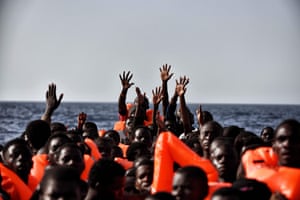
People wait to be rescued as they drift in the Mediterranean off the coast of Libya, October 2016. Photograph: Aris Messinis/AFP/Getty Images
The Mediterranean is the theatre where tensions between Europe’s ideas of human rights do battle with continental politicians’ anxiety about African migration. Until 2009, Libya was a “safe” country of return because countries such as Italy said it was. Italian vessels would intercept migrants and persuade them to clamber off their boats with promises of passage to Italy, and then put them in handcuffs and sail them to Tripoli.
Italy shipped close to 900 people back to Libya in 2009. Among those returnees were 11 Eritreans and Somalis who complained to the European court of human rights. The court’s ruling in 2012 said Italy was guilty of refoulement and had violated the men’s right to claim asylum and not to be returned to an unsafe port. In rejecting Italy’s arguments, one of the judges pointed out that “refugees have the right to have rights.”
This ruling, named the Hirsi ruling after one of the returnees, means any refoulement operation, even one carried out by a proxy force, would be vulnerable to international legal scrutiny if an EU state could be shown to be controlling and directing these operations. Europe had to find allies in Libya who were capable of intercepting migrants on the high seas without overt direction from the Europeans.
The project of building a proxy took off in the summer of 2017. At that time Libya, in the middle of a civil war, had no centralised coastguard and no capacity to manage its own search and rescue area. From the outset it was a joint project between Rome and Brussels: Italy provided ships while the EU trained and paid the new coastguards, often recruiting from among militias and smugglers.
To bolster the legitimacy of the new coastguard, paperwork needed to be lodged with the International Maritime Organization declaring that Libya now managed its own search and rescue zone. Court documents from a case in Catania, Sicily, would later show that one of the first telephone numbers listed for the coastguard was an Italian number.
But European money and material would not be enough to create an effective interception force. The former militiamen and smugglers who were now in coastguard uniforms struggled to reduce crossings. According to leaked internal documents from Operation Sophia from 2018, after more than a year of training and financial support the Libyan coastguard was still unable to control its own search and rescue area. To stop more crossings to Europe, they were going to need even more help.
From 2017 the EU began extending surveillance flights over the zone. Two years later, flights by the EU border agency Frontex almost doubled the size of the EU aerial mission. Under the law of the sea its pilots were bound to contact whichever ship was best placed to assist any boats in distress. But as the Libyans began asserting their presence in the Mediterranean, European flights and their coordinators started giving preference to ships that would take those they rescued southwards, despite the fact that European courts, the UN’s refugee and migration agencies all agree Libya is not a safe country.
Potential legal consequences are now on the horizon. There are four submissions before international courts and two in the Italian system, accusing Italy, the EU or both of funding and directing the Libyan coastguard.
“Italy bypassed Hirsi with an artificial edifice of Libyan power, but [an international court] ruling would show that they can’t use this to evade responsibility,” said Itamar Mann, an Israeli lawyer who is leading litigation efforts against the EU and Italy.
The most recent of these is a complaint to the European court of auditors, the EU’s financial watchdog. The complaint accuses the EU of breaking its own laws by funnelling €90m earmarked for poverty reduction to the Libyan coastguard.
Mann alleges that while the Libyans are carrying out the interceptions, in the background it is the EU pulling the strings. “The EU is using Italy in the same way that Italy is using Libya, to evade responsibility. The main culprit is in Brussels.”
-----------
As Seagull 75 left the scene of the rescue last March, the Libyan coastguard radioed back to Operation Sophia to confirm the coordinates. “Three four zero three north, zero one four three one,” said the coastguard. “That’s correct,” the crew of Seagull 75 replied. The Libyans were pursuing the migrant boats to the northern extreme of Libya’s search and rescue zone.
The coastguard vessel still could not find the first rubber boat. The second boat was being followed by another Sophia plane, a Spanish aircraft with the callsign Cotos, but it too was running low on fuel. It was becoming increasingly clear that only one of the boats would be rescued that night.
Minutes later another European helicopter made radio contact. The Libyan response came back, fast and garbled. “Libyan national coastguard, Libyan national coastguard, can you please speak slowly,” said the helicopter crew. “Do you have visual with the rubber boat?”
The Libyans found the first rubber boat and returned all those onboard to Libya. The Spanish flight trailed the second migrant boat until it ran short on fuel and departed. EU officials would later maintain that those onboard the second boat were rescued by a private oil tanker. However, multiple witnesses who were onboard that tanker say no such rescue occurred. VHF radio recordings from that night corroborate this account.
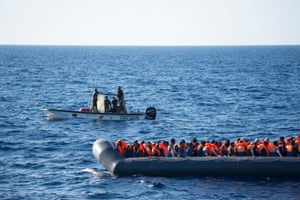
A Libyan coastguard vessel intercepts a rubber boat with around 150 people onboard off the Libyan coast. Photograph: Alamy
The IMO’s search and rescue zones were not designed to exclude potential rescuers. But rescue carries with it the legal responsibility to disembark in a place of safety. After 2012, with Libya stripped of its status as a safe port and the political costs of rescuing migrants rising, European leaders had to find another way to control the Mediterranean.
By early 2019 at EU headquarters in Brussels and at Frontex, Europe’s coastal and border guard agency, senior officials were aware that the scale of their involvement with the Libyans risked making them legally responsible for the fate of returned migrants. A month before the Seagull 75 incident, Fabrice Leggeri, the head of Frontex, wrote to Paraskevi Michou, the highest-ranked migration official in the EU, outlining the problem.
Exchange of letters between senior EU migration official, Paraskevi Michou and Executive Director of Frontex Fabrice Leggeri. (Obtained through FOI)
“Direct exchanges of operational information with the MRCC [Maritime Rescue Coordination Centre] Libya about search and rescue cases may trigger interventions of the Libyan coastguard,” wrote Leggeri. “The development of a Libyan coastguard is funded as you know by the European Union. Nevertheless, the commission and in general institutions may face questions of a political nature as a consequence of the SAR-related operational exchanges of information.”
Couched in official jargon, Europe’s top border official appeared to be asking the EU’s ranking migration official whether they were crossing the line.
The response from Michou a month later sought to reassure him that, legally, they were in the clear. Still, she noted: “[Many] of the recent sightings of migrants in the Libyan SRR [rescue zone] have been provided by aerial assets of [Operation Sophia] and were notified directly to the Libyan RCC responsible for its own region.”
Exchange of letters between senior EU migration official, Paraskevi Michou and Frontex’s Fabrice Leggeri. The letters show the extent of high-level EU concern over engagement with the Libyan Coast Guard. Obtained through FOI
In other words, it was becoming apparent that EU air assets – costing more than €35m in 2019 just for Frontex aircraft – had become the eyes and ears of a Libyan interception force.
In private, some officials from the European agencies most directly involved were uncomfortable with the level of cooperation. An EU border official, who asked not to be identified, told the Guardian there was no difference “between returning someone to an unsafe country or paying someone else to return them”.
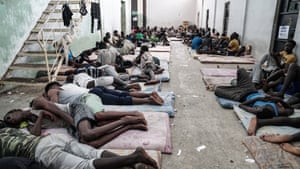 Refugees and migrants at a detention centre in Zawiyah, Libya, in 2017. Photograph: Taha Jawashi/AFP via Getty Images
Refugees and migrants at a detention centre in Zawiyah, Libya, in 2017. Photograph: Taha Jawashi/AFP via Getty Images
In the same period that the Libyan coastguard has been built up operationally and given the facade of legitimacy, private rescue boats run by European charities have faced a sustained campaign of harassment with port closures, arrests and the impounding of ships.
“The Libyan coastguard is not able to locate and track migrant boats itself. In order to do interceptions, they need to be fed from aerial surveillance,” said Tamino Böhm, the head of mission for the German NGO Sea Watch. “Nearly no effective interceptions would take place without an EU air force assisting them.”
Böhm, whose NGO flies its own small surveillance plane through the same skies as Sophia, lists case after case where EU flights relayed data on boats in distress to the Libyan coastguard and to private Libya-bound ships. He notes that NGO vessels and European ships were not called on to rescue as often – a possible violation of international maritime law.
“European actors are not only complicit with but directly responsible for pushbacks to Libya,” Böhm added.
The UN refugee agency’s special envoy for the central Mediterranean, Vincent Cochetel, said nobody in the international community could pretend they did not understand how dangerous Libya had become.
Under these circumstances, he said, “no asset of a third country – naval, aerial or intelligence – should be used to facilitate return from international waters to Libya.”
The main connection between European air surveillance and Libyan interceptions at sea is still the rescue coordination centre in Rome. According to two German legal professors, Anuscheh Farahat and Nora Markard, this makes Italy responsible for internationally wrongful acts, “namely where it violates its obligations under the international law of the sea to make sure a rescue operation leads to a delivery to a place of safety.”

A screengrab taken from an undated video from Frontex shows a fishing trawler pulling away from a wooden boat with refugees and migrants onboard. Photograph: Frontex/EPA
Mario Giro was Italy’s deputy foreign minister for two years while the strategy to support the Libyan coastguard was first being developed. Giro said he believed Italian and European leaders, and in particular Italy’s then interior minister, Marco Minitti, were so focused on stopping the flow of people from Libya that they cut important corners. Italian and European willingness to deal directly with militia members and smugglers was “a mistake, full stop,” Giro said.
“At that time it was very clear that everybody in Italy and in Europe on the right and on the left was obsessed with the question of migrants. And everybody wanted a quick, immediate solution in the name of trying to control the public opinion.”
-----------
Until now the EU and Italy have skirted the line between financing and supporting the Libyan coastguard and taking control of, and therefore responsibility for, its operations. Even when the mask has slipped, as it did when the telephone number listed for Libya’s new rescue centre was listed as an Italian number, the denial of ultimate responsibility is maintained.
“Our personnel are not embedded onboard of Libyan coastguard assets and Eunavfor Med [European Naval Force Mediterranean] personnel are not part of the Libyan coastguard and navy’s decision-making process,” said Peter Stano, a spokesperson for the European External Action Service, the EU’s diplomatic corps. “Nor is EUnavfor Med entitled to exercise any control and authority over Libyan coastguard and navy’s units or personnel.”
Stano denied any direct coordination of the Libyan coastguard. “[EU] air assets do not exercise any coordination of Libyan vessels during rescue operations. There is no reconnaissance programme,” he said.
However, an email sent by a Libyan coastguard commodore to Alarm Phone, a volunteer monitoring group, in August 2019, obtained by the Guardian, states that EU air assets directly pass information to them. “Please be informed that yesterday PV LNCG FEZZAN has conducted nr. 2 S.A.R. events, two rubber boat in dangerous distress (sinking) with about 30 and 50 people on board, North-West of Tripoli (around 70 NM), in PSN 3350N-01239E and 3348N-01218E correlated to reports by EUNAVFORMED air asset D0102 and D0105,” the email said.
Despite the denials, a reckoning appears closer as an array of international legal actions scrutinise every aspect of this cooperation. What emerges, lawyers claim, is a conspiracy to bypass international law and evade responsibility for effectively blocking the Mediterranean.
A senior EU official close to Libya policy at the time described the Mediterranean strategy as a “political timebomb”.
“The EU has taken a major reputational risk,” said the official. “We put our fate in the hands of crooks, the consequences of which are now arriving.”
In late 2017, decision-makers in Brussels were split between a group of hardliners who wanted Europe’s migration control outsourced to Libya and a reduction in sea crossings at all costs, and others who argued that Sophia and the NGO ships should be allowed to continue rescue operations. The hardliners won out. Now, more than two years later, the presence of European rescue ships in the central Mediterranean is minimal.
At the end of the coming year, Frontex, which has begun to assume a greater role in Libya operations, will become the EU’s biggest agency by budget.
In February EU foreign ministers called for a renewal of Sophia, but ministers noted that any indication that it was coming into contact with migrant boats could “lead to the withdrawal of maritime assets from the relevant area”.
The fate of those seeking to escape Libya by boat is likely to mirror that of the migrants caught in the lights of the Seagull 75 in March last year. The occupants of one boat were successfully intercepted by the Libyan coastguard. What happened to those on other boat is contested, but the weight of evidence suggests they are missing, presumed dead.

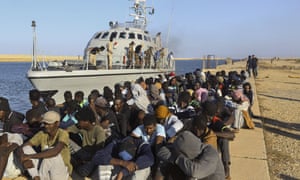 Main image: Rescued refugees and migrants sit next to a coastguard boat in Khoms, Libya, October 2019. Photograph: Hazem Ahmed/AP
Main image: Rescued refugees and migrants sit next to a coastguard boat in Khoms, Libya, October 2019. Photograph: Hazem Ahmed/AP